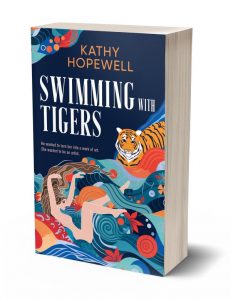From Shadow Artist to First-Time Author: the Surrealist Inspiration Behind my Novel Swimming with Tigers
By Kathy Hopewell
 Julia Cameron’s concept of the shadow artist in The Artist’s Way refers to someone who secretly desires to be creative but is found servicing artists instead, such as an assistant, critic or teacher. To be a shadow artist, in Julia Cameron’s opinion, can conceal an unacknowledged desire to be creative. It’s often a choice made for sensible reasons: teaching poetry is much more likely to provide an income than writing it. But to completely deny the desire to create and instead play out the impulse vicariously can lead to a bitter life of regret, which might explain why reviewers can be so mean!
Julia Cameron’s concept of the shadow artist in The Artist’s Way refers to someone who secretly desires to be creative but is found servicing artists instead, such as an assistant, critic or teacher. To be a shadow artist, in Julia Cameron’s opinion, can conceal an unacknowledged desire to be creative. It’s often a choice made for sensible reasons: teaching poetry is much more likely to provide an income than writing it. But to completely deny the desire to create and instead play out the impulse vicariously can lead to a bitter life of regret, which might explain why reviewers can be so mean!
For many years, I was most definitely a shadow artist. I taught literature and believed that writing poetry and novels was something other people did, most particularly famous dead men. But my field was feminist cultural studies and my academic research kept turning up women from the past who needed to be rescued from obscurity. Eventually, in rescuing them, I rescued myself.
As I researched and taught courses on women writers and artists of the past, it became more and more difficult to resist their inspiring examples and at midlife I stopped shadowing and started creating. As Billie Jean King memorably said: you have to see it to be it. This is particularly true for women who have been told in various ways that they can’t be ‘it’. But women have been doing it for centuries—we just have to know where to look.
For me, it was the women of the surrealist art movement of the 1920s and 1930s who captured my imagination. In the early 2000s when I first encountered the rich and alluring work of artists such as Dorothea Tanning, Leonor Fini and Remedios Varo, the sustained efforts of feminist art historians and curators through the last two decades had meant that their work was becoming better known. I found Leonora Carrington’s extraordinary life and evocative work particularly inspiring.
So, from my knowledge of the surrealist women, I synthesised the plot of a novel. I combined several women’s struggles and triumphs into two main female characters and built a story around them set in the 1930s against the backdrop of the outbreak of war. I borrowed major artworks such as Meret Oppenheim’s notorious teacup covered in fur and retold the experience of the iconic 1938 surrealist exhibition in Paris (which featured a street of mannequins designed to represent female prostitutes) from a woman’s perspective.
I was determined that my women characters would be centre-stage and although they are championed and adored by the men of surrealism it is the bond of friendship between the two of them that pulls them through. This is based on the truth. Whitney Chadwick’s book Women Artists and the Surrealist Movement put women onto the surrealist map, and her recent book The Militant Muse demonstrates that it was the women’s friendship networks that sustained them though exile, war and disappointment.
To write Swimming with Tigers was to reclaim a tradition of lost women artists but it was also to reclaim my own creative ambition. I’ve seen this happen so many times: one woman artist’s liberation inspires another woman to make the jump from shadow artist to working, creating artist. I hope that my novel will do the same and that the surrealist women’s lives and work, as portrayed in my novel, will inspire someone else to step out of the shadows.
References
Julia Cameron The Artist’s Way (1992)
Whitney Chadwick Women Artists and the Surrealist Movement (1985) and The Militant Muse (2017)
Billie Jean King quotation: https://www.billiejeanking.com/
Links
Substack https://thefurcup.substack.com/
Website https://kathyhopewell.com/
Medium (Medium is paywalled, so here is a free link to one article): https://medium.com/writing-cooperative/is-self-publishing-giving-in-fee0048d65f3
SWIMMING WITH TIGERS
Swimming with Tigers is an absorbing novel about friendship and self-discovery set in Europe in the 1930s.
It brings to life the forgotten stories of the women who were part of the surrealist art movement.
It is 1938, and headstrong art student Penelope has left behind her privileged English family to join the surrealists in Paris. In a café, she meets a mysterious, haunted woman who calls herself Suzanne. When Penelope’s artwork is shown at an exhibition, she realises that both she and Suzanne have been betrayed by members of the surrealist group.
Gradually, a friendship develops and together they begin to throw off the subordinate role that the surrealist movement expects of them as women.
The dislocations of war separate Penelope and Suzanne from each other and send them on a desperate chase across France into Spain and finally to Lisbon.
In the darkest of times, will they find a way to save each other?
A story of passion, creativity and courage, Swimming with Tigers is based on real-life women surrealists such as Leonora Carrington and Lee Miller who inspired great art but also wanted to be recognised as artists in their own right.
—
Dr Kathy Hopewell was a lecturer at Bangor University’s Lifelong Learning department for many years and is now a freelance tutor and writer.
As one half of Hopewell Ink, a spoken word and music band, she has performed at many venues in North Wales, created installations for art galleries and been recorded live by BBC Radio 3.
She writes on Medium and has a Substack called The Fur Cup which features imaginary encounters with surrealist art.
Swimming with Tigers, her novel about the women surrealists, was published on October 15th 2024 and you can read more on her website https://kathyhopewell.com/
Category: On Writing























